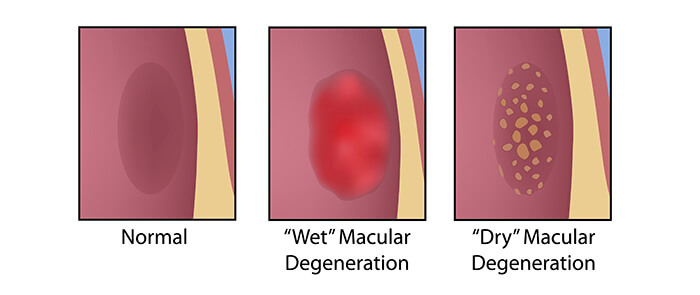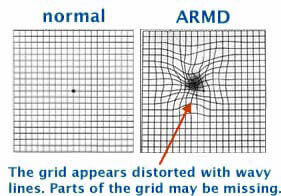Macular Degeneration
INTRODUCTION
If you have been diagnosed with age-related macular degeneration (ARMD) you are in very good company. In the United States alone, a new case is diagnosed every three minutes:
- One in six Americans between the ages of 55 and 64
- One in four between the ages of 64 and 74
- One in three over the age of 75
HOW IT WORKS
Macular degeneration is a disease caused by damage or the breakdown of the macula, a tiny oval area in the retina, where the photoreceptors are most dense and where incoming images are focused.
TYPES
There are two forms of age-related macular degeneration:
- Dry macular degeneration (Atrophic ARMD)
- Wet macular degeneration (Choroidal Neovascularization – CNV)

DRY MACULAR DEGENERATION
The vast majority of cases of ARMD are the dry type, which always precedes the wet type, although it doesn’t always turn into that. Dry refers to the slow degenerative process that occurs in which the macula forms yellow deposits, called drusen and then becomes progressively thinner but does not leak, and so is considered ‘dry’. Progression of dry macular degeneration takes a very long time and does not always affect both eyes equally. Most people usually maintain some central vision in at least one eye.WET MACULAR DEGENERATION (CNV)
Wet ARMD always arises from pre-existing dry ARMD. This occurs in about 10 to 15% of people with advanced dry macular degeneration. Newly formed, abnormal blood vessels grow underneath the retina in the area of the macula. These vessels leak fluid, bleed, and lift up the retina. When this happens central vision is reduced and is often distorted. Eventually, scar-like tissue forms under the macula and the eye loses its ability to see detail. If CNV occurs in one eye, there is an increased chance it will occur in the other eye.SYMPTOMS
There is no pain associated with dry or wet macular degeneration. Vision loss usually occurs gradually and typically affects both eyes at different rates. Sometimes only one eye loses vision while the other eye continues to see well for years. If both eyes are affected, reading and close up work can become quite difficult. Even with a loss of central vision, however, peripheral vision may remain clear.
The center of the macula is called the fovea and is responsible for fine detail vision – our central (or reading) vision, both for distance and close up. When the eye is directed at an object to be seen, whichever part is focused on the fovea will be the clearest, the most in-focus image seen. So, your ability to see fine centralized detail is directly dependent upon the condition of the macula and fovea.
In macular degeneration, something goes wrong with the macula (as explained in more detail below) and it slowly stops working. When this happens, vision fades in the middle (the fovea), usually leaving the peripheral, or side vision. It is uncommon for someone with macular degeneration to lose both macular (detail) and peripheral (side) vision, or to lose vision completely in both eyes.

CAUSES
The root causes of macular degeneration are unknown. Women are at a slightly higher risk than men. Caucasians are more likely to develop macular degeneration than African-Americans.
The macular contains many highly active and sensitive photoreceptors that require and consume a great deal of energy. Generating this energy requires a constant, rich supply of oxygen, nutrients and ions. Consequently, the macula has one of the highest volumes of blood flow through its supply vessels. Anything that interferes with this necessary rich blood supply can cause the macula to malfunction and possibly become diseased.
Smoking is one of those factors that can reduce this vital blood supply by contributing to overall narrowing of the blood vessels and thickening of the blood. A high-fat, high cholesterol diet can lead to fatty plaque deposition in the macular vessels, also hampering blood flow. Nutritional deficiencies, such as shortage of antioxidants, may increase the tendency for fatty deposits to stick to blood vessel walls.
DIAGNOSIS
In order to determine if you have macular degeneration and what form, your doctor will measure your vision and examine your eyes. By looking at the retina, your doctor will be able to tell if there is an abnormality. If drusen are found, you will want to schedule regular check-ups to make sure that no further damage is occurring. It may be necessary that photographs of each macula be taken to use for future comparison.
The following are tests given to fully diagnose AMD:
- Visual acuity test: to measure vision at a distance and close up
- Dilated pupil examination: to see the inside of the eye with an ophthalmoscope to check for drusen.
- Amsler grid: a pattern of straight horizontal and vertical lines (click here for a printable Amsler grid and instructions for use). To the person with ARMD, the lines appear wavy, distorted or missing or a black spot may appear in the center of the grid.
- Optical Coherence Tomography (OCT): uses light waves to create a contour map of the retina and can show areas of thickening or fluid accumulation.
- Fluorescein angiography: If your doctor finds an abnormality and suspects CNV, this special test will be done to detect blood vessels that might be leaking. During the test, a dye is injected into the arm and quickly travels throughout the blood system to the eye. Photographs are taken of the eye, which will later be used during laser treatment.
HOME TEST FOR MACULAR DEGENERATION:
Regardless of the treatment therapy followed, patients with advanced dry macular degeneration should check the vision in each eye, one at a time, at least once a day by staring at the central point on an Amsler grid.
We have provided a printable Amsler grid and instructions for use for you. Patients can help monitor their vision regularly and can detect distortions in vision. These distortions represent the earliest stages of wet macular degeneration.
TREATMENTS
Currently, treatments for macular degeneration are rapidly advancing and changing as often as every three months. Various treatments are currently available, but most of these treatments are directed at the early stages of wet ARMD.
- Thermal laser photocoagulation of the abnormal blood vessels is one treatment for wet AMD. In some cases, laser treatment can be done to prevent or lessen severe loss of eyesight if the CNV is discovered early enough. However, only 15% of patients with wet AMD are eligible for this therapy, and in about 50% of those cases, the blood vessels continue to grow. Overall, this means that laser photocoagulation is only helpful in about 7-8% of patients with wet AMD.The usefulness of laser photocoagulation is limited because of the location of the blood vessels, under the center of the macula. If these blood vessels are treated with the hot laser, the center of the macula would be burned and immediate vision loss would result.When successfully treated, wet macular degeneration is converted back to dry macular degeneration. Over time, there will be continued vision loss, but the outcome is far better than the outcome if the wet AMD was left untreated.
- Photodynamic therapy (PDT) represents the new era in treatment of wet AMD. The clinical trials designed to establish the therapy’s effectiveness, involving more than 900 patients, have resulted in FDA approval for this therapy.The results of the photodynamic therapy trials are a breakthrough for patients with AMD. Until now, there was no treatment that would slow the progression of this disease for the vast majority of patients with wet AMD. While only about 25% of the wet AMD patients will qualify for photodynamic therapy, some 10-15% of patients may even get visual improvement.It is estimated that more than one million people in the United States currently have wet AMD, and 200,000 new cases will be diagnosed this year. This treatment will have a tremendous impact on future advancements.
- Visudyne therapy is based on the technology of photodynamic therapy. It entails a two-step approach designed to affect the abnormal blood vessels in wet AMD:
- A new type of drug, called a photosensitizing agent, is injected into a vein in the arm. The drug circulates throughout the body’s blood vessels, including the abnormal vessels under the macula.
- A cool beam laser is aimed at the abnormal blood vessels, activating the drug. The activated drug selectively affects the abnormal blood vessels without damaging the surrounding retinal tissue. In some cases the therapy stops growth of the abnormal blood vessels and halts the corresponding vision loss.
- Nutrition therapy is certainly encouraged and offers no side effects, except in extremely high dosages. The recent Age-Related Eye Disease Study (AREDS) demonstrated that the progression of dry AMD could be slowed with vitamin supplementation. This study demonstrated the benefits of taking supplements called antioxidants to try to prevent or slow macular degeneration.A potentially important group of antioxidants are called carotenoids. Two carotenoids that occur naturally in the macula are lutein and zeaxanthin. Some research studies suggest that people who have diets high in lutein and zeaxanthin may have a lower risk of developing macular degeneration. Kale, raw spinach, and collard greens are vegetables with the highest amount of lutein and zeaxanthin. You can also buy nutritional supplements that are high in these and other antioxidants, including Vitamin C, Vitamin E, beta-carotene, and zinc along with copper.
- Low vision training may be the only truly effective option for the vast majority of patients. Whether it is vision loss for conditions such as AMD, glaucoma or diabetes, low vision aids help patients perform normal activities of daily living and lead independent lives.Low vision aids range from hand-held magnifying glasses to sophisticated systems that use video cameras to enlarge a printed page. Lifestyle aids such as large print books, tape-recorded books or magazines, large print playing cards, talking clocks and scales and many other devices are also available.
RESEARCH
For those patients with wet AMD, there is significant hope in the very near future. Ongoing clinical research is investigating new treatment strategies using photodynamic therapy. These studies are underway and the preliminary results are very encouraging.
NEW DRUGS:
One recent strategy that seems promising is a new class of drugs known as anti-angiogenic agents, which may stop the formation of blood vessels in wet AMD and cause existing abnormal vessels to regress.
The names of these drugs are rhuFab V2 (Genentech, Inc.), Macugen (Eyetech Pharmaceuticals) and Anecortave acetate (Alcon Research Ltd.). The preliminary results are encouraging, however these drugs are only available at this time to patients participating in a clinical study.
NEW LOW VISION DEVICE:
For those patients who have already experienced vision loss and are somewhat stable, there is a new low vision device that is undergoing clinical investigation. This device is known as an intraocular miniature telescope (IMT) and is inserted into the eye at the time of cataract surgery. While this device may not help all patients with AMD, there is a very good chance that the IMT could improve the ability to read and watch television.
GENETIC RESEARCH:
All treatments, so far, are designed to treat the vision loss associated with wet AMD and slow the progression of the disease. None of the therapies really treat the underlying cause of AMD. While the cause is still unknown, there is solid evidence that this is a disease with a strong genetic basis. For this reason, a great deal of research is going on to find the genes responsible for AMD in the hope of someday developing a cure.